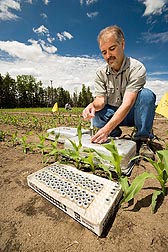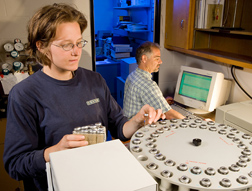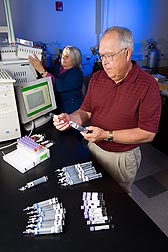New Leads on Nitrous Oxide
Agricultural practices, particularly the use of nitrogen-based fertilizers, generate significant levels of the greenhouse gas nitrous oxide (N2O). But the mechanisms behind these emissions are still nebulous, and some studies suggest that N2O emissions may be underestimated by as much as 40 percent at some sites.
“We need to know much more about how agricultural practices affect the production and consumption of greenhouse gases, including N2O,” says microbiologist Tim Parkin, who works at the ARS Air Quality of Agricultural Systems Research Unit in Ames, Iowa.
Scientists already know that N2O emissions rise as the applications of nitrogen-based fertilizers increase. Parkin and his Ames colleagues collaborated with scientists from AgCert International Limited under a cooperative research and development agreement to learn more about how different soils and fertilizers affect N2O emissions.
The team used chamber studies to assess variation in the emissions of N2O, carbon dioxide, and methane from a sandy loam mix and a clay soil. The fertilizers used were urea-ammonium nitrate (UAN) and a swine manure slurry.
The researchers tracked greenhouse gas emissions for 8 weeks and found that overall N2O emissions were highest from soils amended with swine manure slurry. The emissions peaked shortly after the first fertilizer application and reached a slightly lower peak soon after the first simulated rain.
High levels of N2O emissions were measured from sandy loam soils amended with either UAN or slurry. But on clay soils, only those amended with slurry—and not with UAN—had elevated N2O emissions.
The team concluded that the difference in emissions probably stems in part from key differences between the two soils: cation-exchange capacity (CEC) and water-filled pore space. Higher CEC in clays could reduce the availability of nitrogen for conversion into N2O, and the higher percentage of pore water in the sandy loam could prompt higher denitrification, which in turn boosts N2O emissions.
Looking for Ways To Reduce N2O Emissions
Two hundred miles north of Ames, at the ARS Soil and Water Management Research Unit in St. Paul, Minnesota, collaborator Rod Venterea is asking similar questions.
Venterea’s group has been comparing N2O emissions after application of either urea or anhydrous ammonia fertilizer.
These are two of the most commonly used nitrogen fertilizers in the United States and the world. But U.S. use of anhydrous ammonia has declined by 15 percent over the past three decades, while urea use has nearly tripled.
“Because of their widespread use and changing use patterns, it is important to measure N2O emissions from each fertilizer,” Venterea says. And as it turns out, there is a large difference in N2O emissions between anhydrous ammonia and urea—at least in the corn cropping systems Venterea has been studying.
Over several consecutive growing seasons, Venterea found that the amount of N2O emitted from fields fertilized with anhydrous ammonia was, on average, twice as high as emissions from fields fertilized with urea. These results strongly suggest that N2O emissions may decline in the future as more urea and less anhydrous ammonia is used.
“But this may not be the case in all soils,” Venterea notes. He believes that acidic soils emit the most N2O when anhydrous ammonia is applied and that more alkaline soils may emit lower levels. Plans to confirm this hypothesis with field testing are under way.
Venterea is also working with the agricultural equipment company John Deere to test different techniques for injecting anhydrous ammonia into the soil, which may reduce N2O emissions and increase crop uptake of nitrogen from the soil. He’s also working with other ARS collaborators and specialty fertilizer companies Agrium and AGROTAIN International to determine whether their controlled-release and inhibitor products can lower N2O emissions, reduce nitrate leaching to groundwater, and mitigate other impacts. (See sidebar.)
Tillage and N2O
Another area that Venterea’s group has been studying is how farmers can reduce N2O emissions when using reduced tillage. Reduced tillage (including no-till) is being increasingly looked at for its environmental benefits. “Using less tillage can be a win-win situation,” Venterea says. “It can save on fuel costs, protect the soil from erosion, and conserve water and nutrients.” In some cases, it may also help store carbon in the soil.
Venterea’s work has shown that N2O emissions with reduced tillage can be minimized by injecting the fertilizer below the upper 2 to 3 inches of soil. “This upper layer is where all the microorganisms that support N2O emissions are concentrated in a reduced tillage soil, so you need to avoid placing the fertilizer there,” he says.
Maximizing Measurement Estimates
In a crop field, it’s a challenge to take comprehensive measurements of anything. So most measurements of N2O emissions are conducted using chambers that are placed on the soil surface for short periods. The rate of N2O emissions is then estimated based on how quickly N2O accumulates inside the chamber.
But placement of the chamber itself can disturb the emission rate. “This so-called chamber effect is something we’ve known about for decades, and it continues to hinder us in making very accurate measurements in the lab,” Venterea says.
So Venterea developed a spreadsheet-based error-calculation tool, based on gas-transport theory, that allows researchers to estimate the error caused by any given chamber type in a given soil. Venterea has posted the spreadsheet on the World Wide Web at www.ars.usda.gov/SP2UserFiles/person/31831/CEAT2.0.xls.
“The goal is to help people design measurement systems that minimize errors and also to estimate the amount of error they are getting,” Venterea says.—By Ann Perry, Agricultural Research Service Information Staff.
This research is part of Global Change (#204) and Soil Resource Management (#202), two ARS national programs described on the World Wide Web at www.nps.ars.usda.gov.
Timothy B. Parkin is with the USDA-ARS Air Quality of Agricultural Systems Research Unit, 2110 University Blvd., Ames, IA 50011-3120; phone (515) 294-6888, fax (515) 294-8125.
Rodney T. Venterea is with the USDA-ARS Soil and Water Management Research Unit, 439 Borlaug Hall, St. Paul, MN 55108; phone (612) 624-7842, fax (651) 649-5175.
Specially Formulated Fertilizers Reduce Greenhouse Gas
Climate and soil conditions in the Central Great Plains make nitrogen fertilizers a necessity for ensuring sufficient yields of corn, barley, dry beans, and soybeans. But using nitrogen fertilizers leads to release of nitrous oxide (N2O), a major greenhouse gas, into the atmosphere. They are one of the reasons an estimated 78 percent of the nation’s N2O emissions come from agriculture.
At the Soil Plant Nutrient Research Unit in Fort Collins, Colorado, soil scientist Ardell Halvorson is examining the effects of altering the types and amounts of fertilizers growers apply to minimize N2O emissions and maximize crop yields.
Halvorson is comparing N2O emissions from no-till corn fields treated with conventional nitrogen fertilizer (urea) or either of two specially formulated urea fertilizers: one with controlled-release polymer-coated pellets or one with stabilizers added to keep more of the urea in the soil as ammonium for a longer period. He chose a no-till system because it is known to reduce carbon dioxide emissions.
After 2 years, he found that the specially formulated fertilizers drastically reduced N2O emissions. The controlled-release fertilizer cut N2O emissions by a third, and the stabilized fertilizer cut them almost in half.
Halvorson’s results so far are limited to the irrigated fields and cool, semi-arid conditions at Fort Collins. But N2O releases are the result of a complex interplay of varying conditions. Soil organic matter, rainfall distribution, climatic conditions, and soil variability affect microbial activity and potential for N2O release from nitrogen application. So Halvorson is expanding the study, with financial support from the fertilizer industry and cooperation of other ARS locations, to see how the fertilizers respond at seven sites around the United States.—By Dennis O'Brien, Agricultural Research Service Information Staff.
Ardell Halvorson is in the USDA-ARS Soil Plant Nutrient Research Unit, 2150 Centre Ave., Bldg. D, Suite 100, Fort Collins, CO 80526; phone (970) 492-7230, fax (970) 492-7213.
"New Leads on Nitrous Oxide" was published in the November/December 2009 issue of Agricultural Research magazine.









